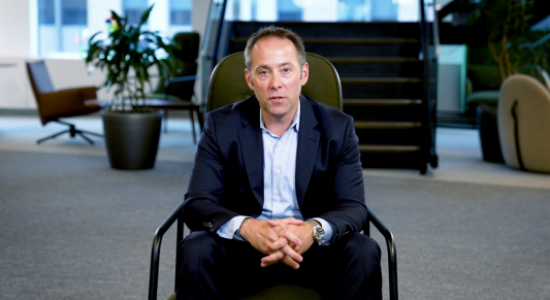 We've built our industrial economy and the energy infrastructure that makes it run over the course of many, many decades. Likewise, the transition to clean energy will take time
We've built our industrial economy and the energy infrastructure that makes it run over the course of many, many decades. Likewise, the transition to clean energy will take time
- About this video
- Transcript
Transitioning toward cleaner sources of energy, such as electricity, requires a lot of time and investment. Discover the steps utilities are taking to drive this change.
Oliver Wyman Takes On Series
In this video series, energy and natural resources experts share their take on how businesses can harness risk, turn climate intent into action, and lead in the age of acceleration.
The energy transition is not a single-dimensional concept, but rather a broad effort to power the world economy in more environmentally responsible ways. Sometimes the pace of change seems glacial, but I can tell you, definitively, it is accelerating. Only a decade ago, gas was broadly thought of as a clean alternative to coal. Now, it is broadly thought of as just another dirty hydrocarbon, already facing bans in many US communities.
Hi, I'm Curt Underwood and I lead Oliver Wyman's North America Utilities Practice and our Boston office. I've built my career helping organizations improve their operations, enabling them to grow and meet new challenges. Recently, a lot of our work has been focused on helping our clients meet the challenges brought on by the changing landscape of the energy sector. This industry is under a significant period of change, and we are only in the very early stages of shifting away from dirtier hydrocarbon-based fuels and transitioning to cleaner sources of energy.
In many ways, my career path has followed the energy transition. I started in the oil and gas industry, focused on pipelines and logistics, later moving to utilities and their vast energy infrastructure networks, which play a massively outsized role in the energy transition. For me, the infrastructure buildout required to bring clean energy to consumers and businesses is one of the most critical and interesting parts of the energy transition.
We have been talking about sustainability for decades, but only recently did the transition become very real for me. I started seeing much more investment from private equity, infrastructure funds, and governments in clean energy technologies. One of the largest is the US Inflation Reduction Act, which is adding hundreds of billions of investment and incentives to support the transition for the US energy industry. I see consumers, investors, and insurers recognizing the importance of clean energy sources and getting actively involved in making it a reality. The energy transition has indeed gotten very real, very quickly.
Electrification will be one of the more interesting aspects of the energy transition. The idea is that in utilizing electricity to power transportation, heating, industrial applications, and others, our energy footprint gets greener as the sources of generation get greener. Today, 60% of the US electric industry generation comes from hydrocarbon-based sources. Many of these plants have long remaining lifespans and relatively low marginal costs of power and won't be retired anytime soon. As we continue to develop renewable sources of generation, in some cases with storage, the average carbon intensity of power will be reduced.
We've built our industrial economy and the energy infrastructure that makes it run over the course of many, many decades. Likewise, the transition to clean energy will take time. In addition to time, it will take a lot of investment to build the infrastructure required to enable electrification. A few years ago, a colleague and I wrote an article in an attempt to put the infrastructure challenge of electrification into context. We found that electrification of passenger and light-duty vehicles alone represent an increase in total electricity demand by 50%. This year, at an industry conference, I heard Bill Gates and Elon Musk cite similar statistics, this time including a broader range of transportation, industrials, and heating. They cited statistics of a three times increase in electricity demand in the US. Suffice to say that the grid, which has been designed to run with high utilization under current load conditions, will require massive amounts of investment to deal with a doubling or tripling of demand. These two well-known business personalities had a common message — get started building now, infrastructure is very likely to be a bottleneck, which could prevent the advancement of a clean energy agenda.
Clearly utilities have a very important role to play. They are supporting the EV transition by building out charging infrastructure and working with automakers to promote EV adoption. They are also electrifying key hubs, such as industrial areas, airports, and seaports. Utilities are investing in clean power generation themselves, where they are allowed to, and helping others get connected to the grid to bring electricity to the interconnected market. More importantly, they are building out transmission and distribution infrastructure — the poles and wires that form the backbone of the economy. All of this requires significant investment in siting, permitting, and technology to expand capacity, improve efficiency, and reduce the total load. Utilities are truly at the heart of the energy transition and I'm proud to be working in this industry.
My team has gotten to help utilities get fit for growth, help distributed energy manufacturers better target growth opportunities, assess development risks for offshore wind projects, and develop growth strategies for EV charging manufacturers. It is really an exciting time to be working in energy and helping our clients navigate the energy transition.
The transition to cleaner energy sources is a long and challenging journey, but it is one that we must undertake for the sake of our planet and future generations.
I'm Curt Underwood, and that's my take on the role of utilities in the energy transition.
This transcript has been edited for clarity.
- About this video
- Transcript
Transitioning toward cleaner sources of energy, such as electricity, requires a lot of time and investment. Discover the steps utilities are taking to drive this change.
Oliver Wyman Takes On Series
In this video series, energy and natural resources experts share their take on how businesses can harness risk, turn climate intent into action, and lead in the age of acceleration.
The energy transition is not a single-dimensional concept, but rather a broad effort to power the world economy in more environmentally responsible ways. Sometimes the pace of change seems glacial, but I can tell you, definitively, it is accelerating. Only a decade ago, gas was broadly thought of as a clean alternative to coal. Now, it is broadly thought of as just another dirty hydrocarbon, already facing bans in many US communities.
Hi, I'm Curt Underwood and I lead Oliver Wyman's North America Utilities Practice and our Boston office. I've built my career helping organizations improve their operations, enabling them to grow and meet new challenges. Recently, a lot of our work has been focused on helping our clients meet the challenges brought on by the changing landscape of the energy sector. This industry is under a significant period of change, and we are only in the very early stages of shifting away from dirtier hydrocarbon-based fuels and transitioning to cleaner sources of energy.
In many ways, my career path has followed the energy transition. I started in the oil and gas industry, focused on pipelines and logistics, later moving to utilities and their vast energy infrastructure networks, which play a massively outsized role in the energy transition. For me, the infrastructure buildout required to bring clean energy to consumers and businesses is one of the most critical and interesting parts of the energy transition.
We have been talking about sustainability for decades, but only recently did the transition become very real for me. I started seeing much more investment from private equity, infrastructure funds, and governments in clean energy technologies. One of the largest is the US Inflation Reduction Act, which is adding hundreds of billions of investment and incentives to support the transition for the US energy industry. I see consumers, investors, and insurers recognizing the importance of clean energy sources and getting actively involved in making it a reality. The energy transition has indeed gotten very real, very quickly.
Electrification will be one of the more interesting aspects of the energy transition. The idea is that in utilizing electricity to power transportation, heating, industrial applications, and others, our energy footprint gets greener as the sources of generation get greener. Today, 60% of the US electric industry generation comes from hydrocarbon-based sources. Many of these plants have long remaining lifespans and relatively low marginal costs of power and won't be retired anytime soon. As we continue to develop renewable sources of generation, in some cases with storage, the average carbon intensity of power will be reduced.
We've built our industrial economy and the energy infrastructure that makes it run over the course of many, many decades. Likewise, the transition to clean energy will take time. In addition to time, it will take a lot of investment to build the infrastructure required to enable electrification. A few years ago, a colleague and I wrote an article in an attempt to put the infrastructure challenge of electrification into context. We found that electrification of passenger and light-duty vehicles alone represent an increase in total electricity demand by 50%. This year, at an industry conference, I heard Bill Gates and Elon Musk cite similar statistics, this time including a broader range of transportation, industrials, and heating. They cited statistics of a three times increase in electricity demand in the US. Suffice to say that the grid, which has been designed to run with high utilization under current load conditions, will require massive amounts of investment to deal with a doubling or tripling of demand. These two well-known business personalities had a common message — get started building now, infrastructure is very likely to be a bottleneck, which could prevent the advancement of a clean energy agenda.
Clearly utilities have a very important role to play. They are supporting the EV transition by building out charging infrastructure and working with automakers to promote EV adoption. They are also electrifying key hubs, such as industrial areas, airports, and seaports. Utilities are investing in clean power generation themselves, where they are allowed to, and helping others get connected to the grid to bring electricity to the interconnected market. More importantly, they are building out transmission and distribution infrastructure — the poles and wires that form the backbone of the economy. All of this requires significant investment in siting, permitting, and technology to expand capacity, improve efficiency, and reduce the total load. Utilities are truly at the heart of the energy transition and I'm proud to be working in this industry.
My team has gotten to help utilities get fit for growth, help distributed energy manufacturers better target growth opportunities, assess development risks for offshore wind projects, and develop growth strategies for EV charging manufacturers. It is really an exciting time to be working in energy and helping our clients navigate the energy transition.
The transition to cleaner energy sources is a long and challenging journey, but it is one that we must undertake for the sake of our planet and future generations.
I'm Curt Underwood, and that's my take on the role of utilities in the energy transition.
This transcript has been edited for clarity.
Transitioning toward cleaner sources of energy, such as electricity, requires a lot of time and investment. Discover the steps utilities are taking to drive this change.
Oliver Wyman Takes On Series
In this video series, energy and natural resources experts share their take on how businesses can harness risk, turn climate intent into action, and lead in the age of acceleration.
The energy transition is not a single-dimensional concept, but rather a broad effort to power the world economy in more environmentally responsible ways. Sometimes the pace of change seems glacial, but I can tell you, definitively, it is accelerating. Only a decade ago, gas was broadly thought of as a clean alternative to coal. Now, it is broadly thought of as just another dirty hydrocarbon, already facing bans in many US communities.
Hi, I'm Curt Underwood and I lead Oliver Wyman's North America Utilities Practice and our Boston office. I've built my career helping organizations improve their operations, enabling them to grow and meet new challenges. Recently, a lot of our work has been focused on helping our clients meet the challenges brought on by the changing landscape of the energy sector. This industry is under a significant period of change, and we are only in the very early stages of shifting away from dirtier hydrocarbon-based fuels and transitioning to cleaner sources of energy.
In many ways, my career path has followed the energy transition. I started in the oil and gas industry, focused on pipelines and logistics, later moving to utilities and their vast energy infrastructure networks, which play a massively outsized role in the energy transition. For me, the infrastructure buildout required to bring clean energy to consumers and businesses is one of the most critical and interesting parts of the energy transition.
We have been talking about sustainability for decades, but only recently did the transition become very real for me. I started seeing much more investment from private equity, infrastructure funds, and governments in clean energy technologies. One of the largest is the US Inflation Reduction Act, which is adding hundreds of billions of investment and incentives to support the transition for the US energy industry. I see consumers, investors, and insurers recognizing the importance of clean energy sources and getting actively involved in making it a reality. The energy transition has indeed gotten very real, very quickly.
Electrification will be one of the more interesting aspects of the energy transition. The idea is that in utilizing electricity to power transportation, heating, industrial applications, and others, our energy footprint gets greener as the sources of generation get greener. Today, 60% of the US electric industry generation comes from hydrocarbon-based sources. Many of these plants have long remaining lifespans and relatively low marginal costs of power and won't be retired anytime soon. As we continue to develop renewable sources of generation, in some cases with storage, the average carbon intensity of power will be reduced.
We've built our industrial economy and the energy infrastructure that makes it run over the course of many, many decades. Likewise, the transition to clean energy will take time. In addition to time, it will take a lot of investment to build the infrastructure required to enable electrification. A few years ago, a colleague and I wrote an article in an attempt to put the infrastructure challenge of electrification into context. We found that electrification of passenger and light-duty vehicles alone represent an increase in total electricity demand by 50%. This year, at an industry conference, I heard Bill Gates and Elon Musk cite similar statistics, this time including a broader range of transportation, industrials, and heating. They cited statistics of a three times increase in electricity demand in the US. Suffice to say that the grid, which has been designed to run with high utilization under current load conditions, will require massive amounts of investment to deal with a doubling or tripling of demand. These two well-known business personalities had a common message — get started building now, infrastructure is very likely to be a bottleneck, which could prevent the advancement of a clean energy agenda.
Clearly utilities have a very important role to play. They are supporting the EV transition by building out charging infrastructure and working with automakers to promote EV adoption. They are also electrifying key hubs, such as industrial areas, airports, and seaports. Utilities are investing in clean power generation themselves, where they are allowed to, and helping others get connected to the grid to bring electricity to the interconnected market. More importantly, they are building out transmission and distribution infrastructure — the poles and wires that form the backbone of the economy. All of this requires significant investment in siting, permitting, and technology to expand capacity, improve efficiency, and reduce the total load. Utilities are truly at the heart of the energy transition and I'm proud to be working in this industry.
My team has gotten to help utilities get fit for growth, help distributed energy manufacturers better target growth opportunities, assess development risks for offshore wind projects, and develop growth strategies for EV charging manufacturers. It is really an exciting time to be working in energy and helping our clients navigate the energy transition.
The transition to cleaner energy sources is a long and challenging journey, but it is one that we must undertake for the sake of our planet and future generations.
I'm Curt Underwood, and that's my take on the role of utilities in the energy transition.
This transcript has been edited for clarity.


